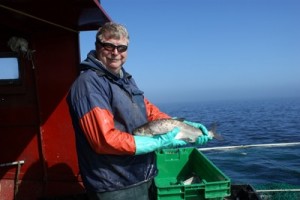Whitefish Changes Diet to Survive
- Share
- Tweet
- Pin
- Share
Broiled, blackened, fried or fish boiled, the whitefish means more to Door County menus than any other fish.
But as recently as 2006 the people who know the fish best feared the end was near. After a century of battling back from overfishing, the destruction of spawning grounds, and competition from alewives and mussels, it appeared the stubborn whitefish had met its match in the invasive round goby.

Commercial fisherman Charlie Henriksen with a freshly caught whitefish, which shocked all the experts by changing its diet to survive.
“Those were supposed to be the end of everything,” says commercial fisherman Charlie Henriksen, now in his fourth decade fishing Lake Michigan.
The whitefish were already struggling thanks to the invasive quagga mussel, which arrived in 1989 but exploded across the lake bed in 2002. The quagga feasts on diporeia, the same zooplankton the whitefish rely on, and nearly cleared the lake of them. Now whitefish faced the goby, which feasts on the eggs of whitefish and smallmouth bass, and it was thought that the whitefish would be defenseless.
The goby is a 4- to 10-inch fish native to the Caspian Sea. It was brought to the Great Lakes in the ballast water of ocean-going vessels in 1990, but wasn’t detected in significant numbers in Lake Michigan until 1999.
“The goby is a nest egg predator,” explained Scott Hansen, a fisheries biologist with the Wisconsin Department of Natural Resources. “So there was a fear that they would wipe out smallmouth bass and whitefish eggs. Both of these fish are nesting species. If the male doesn’t guard the eggs the goby can really have an impact.”
But a remarkable if not unprecedented story unfolded. Researchers and fishermen began to find strange things in whitefish bellies. With their preferred food source depleted, they changed their diet and began feeding on the gobies, alewives, yellow perch and even mussels.
“It’s really amazing,” Hansen said. “Gobies are probably an easy target because they don’t move as quickly. It’s fairly unique for a species to be able to do this. So far, though it’s still kind of early, the preliminary data shows that it doesn’t seem that gobies have made a tremendous impact on whitefish or smallmouth bass.”
The whitefish are in greater abundance than they’ve been in years, and it’s not just the goby. In the early part of the 20th century commercial fishermen overfished the whitefish and the lake trout. Logging, pollution and dams devastated tributaries once great for spawning. In 1879 11 million kg of whitefish were caught on Lakes Michigan, Huron and Superior. In 1959, the total Great Lakes harvest was just 701,000 kg.
But catch limits and 30 years of cleanup mandated by the Clean Air and Water Acts finally paid off in the late 1990s, as the whitefish began to return to native spawning grounds such as the Menominee River and the west bank of Green Bay.
All the news isn’t good, however. Today’s whitefish, though more abundant, is not the whitefish of 25 years ago. The fish grow much more slowly. In the early 1990s a whitefish would reach 17 inches – the minimum legal length limit for commercial fishermen –in three to four years in the waters around Door County. Today, it takes seven years or more.
Hansen says there are two lines of thought for explaining the change.
One blames density. When you have more whitefish – and more invasives – there are simply more mouths to feed.
The other is the quality of the whitefish’s new diet as a nutrient source.
“The diporeia was a very abundant, nutrient-rich food source,” Hansen said. “What they’re feeding on now isn’t as nutrient dense as the diporeia.”
How long the whitefish can sustain themselves on their new diet remains to be seen. Lake Michigan’s ebbs and flows come quickly. Disease, a big harvest, strange weather conditions can have dramatic year-over-year impacts on the population of a species.
“No one dreamt salmon would reproduce in Lake Michigan, but they do,” Henriksen said. “No one dreamt whitefish would eat the gobies. The lake is so dynamic and changes so quickly, and there are so many examples of things that have not gone the way anyone expected them to. You can do all the managing you want to do, but Mother Nature is still in charge.”

